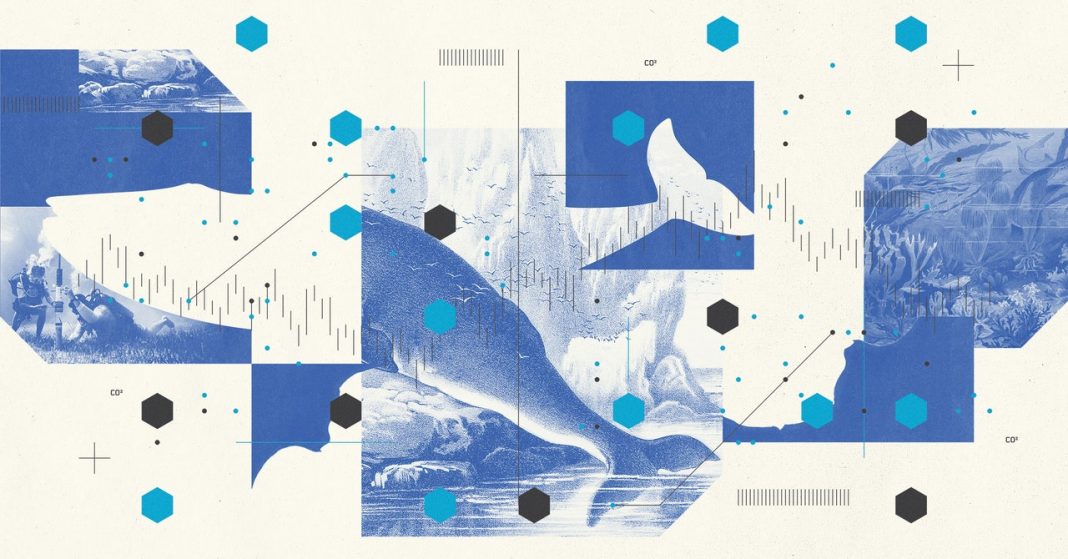Duarte sees the project in the Bahamas as a blueprint (pun intended, he says) for a much grander idea that has animated his work for the past two decades: He wants to restore all aquatic habitats and creatures to their preindustrial bounty. He speaks in terms of “blue natural capital,” imagining a future in which the value of nature is priced into how nations calculate their economic productivity.
This is different from past efforts to financialize nature, he emphasizes. Since the 19th century, conservationists have argued that protecting bison or lions or forests is a sound investment because extinct animals and razed trees can no longer provide trophies or timber. More recently, ecologists have tried to demonstrate that less popular habitats, such as wetlands, can serve humanity better as flood protectors or water purifiers than as sites for strip malls. But while these efforts may appeal to hunters or conservationists, they are far from recasting nature as a “global portfolio of assets,” as a Cambridge economist described natural capital in a 2021 report commissioned by the UK government.
Duarte and I first met in the halls of a crowded expo at the 2022 UN Climate Conference in Sharm el-Sheikh, Egypt. He had traveled a short distance from his home in Jeddah, where he oversees a wide array of projects, from restoring corals and advising on regenerative tourism projects along Saudi Arabia’s Red Sea coast to a global effort to scale up seaweed farming (using, yes, revenue from carbon credits). In Egypt, Duarte was scheduled to appear on 22 panels, serving as the scientific face of the kingdom’s plan for a so-called circular carbon economy, in which carbon is treated as a commodity to be managed more responsibly, often with the help of nature.
Chami was there too, wearing a trim suit and a pendant in the shape of a whale’s tail around his neck. He was participating as a member of the Bahamian delegation, which included Prime Minister Davis and various conservationists from Beneath the Waves. They had arrived with a pitch for how to include biodiversity in global discussions about climate change. The seagrass was their template, one that could be replicated across the world, ideally with the Bahamas as a hub for natural markets.
The UN meeting was a good place to spread the gospel of seagrass. The theme of the conference was how to get wealthy polluters to pay for the damage they cause in poorer nations that experience disasters such as Hurricane Dorian. The hope was to eventually hammer out a UN agreement, but in the meantime, other approaches for moving money around were in the ether. Since the 2015 Paris Agreement, countries had been forced to start accounting for carbon emissions in their balance sheets. Big emitters were lining up deals with cash-poor, biodiversity-rich nations to make investments in nature that would potentially help the polluters hit their climate commitments. Chami’s boss at the IMF had suggested that nations in debt could start to think about using their natural assets, valued in carbon, to pay it off. “All of these poor countries today are going to find out that they’re very, very rich,” Chami told me.
At a conference where the main message often seemed to be doom, the project in the Bahamas was a story of hope, Chami said. When he gave a talk about the seagrass, he spoke with the vigor of a tent revivalist. With the time humanity had left to fix the climate, he told the audience, “cute projects” weren’t going to cut it anymore. A few million dollars for seagrass replanting here, a handful of carbon credits for protecting a stand of mangroves there—no, people needed to be thinking a thousand times bigger. Chami wanted to know what everyone gathered in Egypt was waiting for. “Why are we dilly-dallying?” he asked the crowd. “So much talk. So little action.”
One day this past winter, a former real estate developer from Chattanooga, Tennessee, named David Harris piloted his personal jet over the Little Bahama Bank. From his cockpit window, the water below looked like the palette of a melancholic painter. Harris was bound for a weed-cracked landing strip in West End, Grand Bahama, where he would board a fishing boat called the Tigress. Harris and his crew—which included his 10-year-old daughter—would spend the rest of the week surveying seagrass meadows for Beneath the Waves.
They were tackling a great expanse. While the total land area of the Bahamas is a mere 4,000 square miles, the islands are surrounded by shallow undersea platforms roughly 10 times that size. These banks are the work of corals, which build towering carbonate civilizations that pile atop one another like the empires of Rome. When the first seagrasses arrived here about 30 million years ago, they found a perfect landscape. The plants do best in the shallows, closest to the light.
